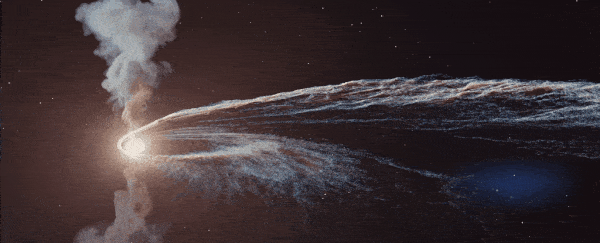A high-energy neutrino traced back to a violent encounter between a black hole and a star needs a different origin story, new research has found.
An analysis of radio waves emitted by the encounter, known as AT2019dsg, has shown that it was fairly ordinary, at least as far as a black hole tearing apart a star goes. That means that the event wasn't energetic enough to produce the neutrino months later – that the events were merely coincidental.
"Instead of seeing the bright jet of material needed for this, we see a fainter radio outflow of material," said astronomer Kate Alexander of Northwestern University. "Instead of a powerful firehose, we see a soft wind."
The death of a star by a black hole isn't a neat and tidy process. When an errant star comes close enough to a black hole that it's snared by the latter object's gravity, the colossal tidal force of the black hole – the product of its gravitational field – first stretches and then pulls the star so hard that it's torn apart.
This is called a tidal disruption event (TDE). It releases a brilliant flare of light, glowing brightly as half of the debris from the disintegrated star swirls into a disc around the black hole, generating immense heat and light before it's pulled inexorably beyond the event horizon. The other half of the debris gets flung out into space.
AT2019dsg, first detected on 9 April 2019, was just such an event, from a galaxy 750 million light-years away. X-ray and radio observations confirmed a supermassive black hole 30 million times the mass of the Sun undergoing a TDE. Nearly six months later, on 1 October 2019, a neutrino called IC191001A was detected at the IceCube neutrino detector in Antarctica, clocking in at a whopping energy level of over 200 teraelectronvolts.
Neutrinos are called 'ghost particles' because their mass is almost zero, they travel at near light-speed, and they don't really interact with normal matter; to a neutrino, the Universe would be all but incorporeal. Occasionally, however, they do interact, and this is how IceCube works. When a neutrino interacts with the Antarctic ice, it can create a flash of light. With detectors tunneled deep under that ice, those flashes really stand out.
Based on characteristics such as how the light propagates, and how bright it is, scientists can work out the energy level of the neutrino, and the direction from whence it came. IC191001A came from the direction of AT2019dsg, so closely that scientists calculated just a 0.2 percent chance that the neutrino and TDE were unrelated.
But that raised some significant issues.
"If this neutrino somehow came from AT2019dsg, it begs the question: Why haven't we spotted neutrinos associated with supernovae at this distance or closer?" said astronomer Yvette Cendes of the Center for Astrophysics | Harvard & Smithsonian.
"They are much more common and have the same energy velocities."
The research team, led by Cendes, used the Atacama Large Millimeter/submillimeter Array in Chile to observe AT2019dsg for over 500 days in radio wavelengths. They found that the TDE continued to brighten in radio wavelengths for around 200 days, at which point it peaked and began to slowly dim.
They also calculated the total amount of energy in the TDE outflow: It was about as much energy emitted by the Sun over 30 million years. That's pretty standard for a TDE, as well as type Ib and type Ic supernovae.
In order to produce a neutrino as energetic as IC191001A, the energy of the outflow would need to have been around 1,000 times greater.
In addition, it would need to have had a strange geometry, which AT2019dsg's outflow did not. AT2019dsg is really rather ordinary, after all. Since IC191001A is not ordinary, a new explanation might be warranted.
But there's a lot we still don't know about neutrinos, and TDEs for that matter. This means AT2019dsg is going to continue being of interest.
"We're probably going to check in on this one again," Cendes said. "This particular black hole is still feeding."
The research has been published in The Astrophysical Journal.
